Profiles in Online Learning: Tyler, Clarinet Student
 We’re pleased to bring you another profile in online learning, this time from one of Ricardo Morales’ clarinet students. Tyler grew up in Green Bay, WI and is currently finishing up a master's degree in clarinet performance at the University of New Mexico.
We’re pleased to bring you another profile in online learning, this time from one of Ricardo Morales’ clarinet students. Tyler grew up in Green Bay, WI and is currently finishing up a master's degree in clarinet performance at the University of New Mexico.
AW: What instruments do you play?
Tyler: I started out taking piano lessons from my grandma and then took up the clarinet in 5th grade. During my undergrad, I studied both clarinet and piano before finally choosing clarinet in grad school.
Ricardo Morales on Practicing Clarinet Scales
 AW: How should students practice clarinet scales on a daily basis, as well as on a weekly basis?
AW: How should students practice clarinet scales on a daily basis, as well as on a weekly basis?
Ricardo: Clarinet scales must be practiced a great deal and often, because just about everything in Western music is based on scales and arpeggios. It only takes a few seconds to look at any piece of music to find how integral scales and arpeggios are to how melodies are constructed.
The trick to practicing clarinet scales is to have "music" in mind when practicing scales. If one does not, while it may be helpful in a technical sense, it will not be as useful as we need them to be. Practicing clarinet scales in an abstract way is about as useful as learning vocabulary randomly from the dictionary - it may be good for a spelling bee contest, but when it comes to music, we should learn the words for writing, or singing poetry through music.
The chromatic scale should be practiced daily, as it comprises of all the half steps in our instruments. It is also used in a great deal of passage work that requires speed, so familiarity with it is of great importance.
Weekly study of our "challenging" key scales will keep our fingers nimble and getting used to the finger patterns that are hard. Familiarity with the difficult finger combinations is the best way to eliminate or ease our use of those keys.
Clarinet Embouchure - Why Double Lip is Better
Embouchure (pronounced ˌämbo͞oˈSHo͝or) refers to how we use the mouthpiece on a wind or brass instrument. When talking about clarinet embouchure, there are two kinds: single lip and double lip embouchure.
To give you a little clarinet history: before the 1820s everyone played clarinet with the reed on top, which forced you to use double lip embouchure. Then in the 1820s, Germans clarinet players introduced a new way of playing clarinet with the reed on the bottom, which gave birth to single lip embouchure. As you'll discover in this sample video from Ricardo Morales' online clarinet lessons, there's actually more reasons to play clarinet using a double lip embouchure as opposed to the more commonly used single lip embouchure.
Mastering Shostakovich Symphony #1 for Clarinet
Shostakovich Symphony #1 1st Movement is an essential clarinet excerpt and has many solos that require clear articulation, good rhythm and energetic playing.
The above video clarinet lesson from the Online Classical Clarinet School with Ricardo Morales breaks down several of the clarinet solos.






